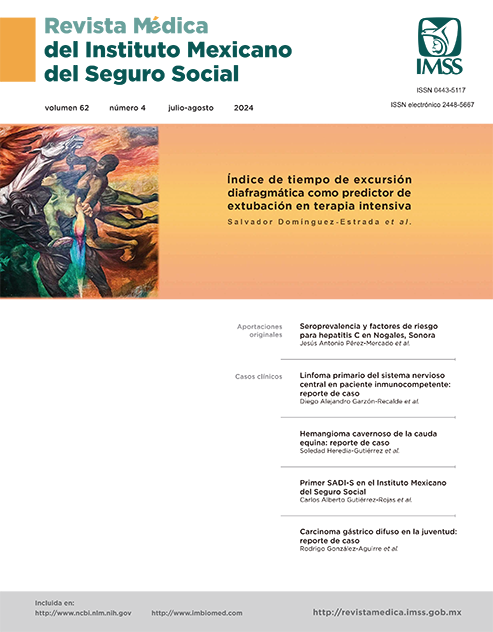Risk of postpartum depression in primary care
Main Article Content
Keywords
Depression, Postpartum Period, Pregnancy
Abstract
Background: Postpartum depression (PPD) is a severe mental disorder that can affect up to 56% of Latina women. PPD has multiple origins and affects maternal well-being, health and behavior, as well as child development.
Objective: to analyze the risk of postpartum depression in a primary care center.
Material and methods: observational, cross-sectional, retrospective study in patients entitled to primary care, who were in the postpartum period. Likert-type surveys were carried out, based on the Edinburgh Scale, collecting sociodemographic factors, in order to establish the associated risk factors. The association between the study outcome (risk of postpartum depression) with each independent variable was determined using Odds ratio and multivariate models.
Results: 79 postpartum patients were included, the average age was 29 years (± 5), 46.8% with a high risk of depression, and 53.2% without risk of postpartum depression. The main factor associated with being able to present a high risk of postpartum depression was low socioeconomic level in 94.6%, other variables did not have statistical significance.
Conclusions: the frequency of being at high risk for postpartum depression in our study was similar to that reported by the Pan American Health Organization 2018, with a frequency of 56% in Mexican and Latin American women. The main risk factor was economic aspects rather than social aspects.
References
Caparros-Gonzalez RA, Romero-Gonzalez B, Peralta-Ramirez MI. Depresión posparto, un problema de salud pública mundial. Revista Panamericana de Salud Pública. 2018;42(1). Disponible en: https://iris.paho. org/bitstream/handle/10665.2/49117/v42e972018. pdf?sequence=3&isAllowed=y.
Ortiz-Martinez RA, Gallego-Betancourt CX, Buitrón-Zúñiga EL, et al. Prevalence of Positive Screen for Postpartum De-pression in a Tertiary Hospital and Associated Factors. Rev Colomb Psiquiatr. 2016;45(4):253-261.
Lara M, Patiño P, Navarrete L, et al. Depresión posparto, un problema de salud pública que requiere de mayor atención en México. Género y Salud en cifras. 2017;15(2):12-25. Disponible en: https://www.gob.mx/cms/uploads/attachment/ file/280078/2-depresionpostparto.pdf.
Zeleke TA, Getinet W, Tadesse-Tessema Z, et al. Prevalence and associated factors of post-partum depression in Ethiopia. A systematic review and meta-analysis. PLoS One. 2021;16 (2):e0247005.
Orozco W. Depresión postparto. Revista Médica de Costa Rica y Centroamérica. 2013;LXX(608):639-647. Disponible en: https://www.binasss.sa.cr/revistas/rmcc/608/art14.pdf.
Malpartida-Ampudia MK. Depresión postparto en atención primaria. Revista Médica Sinergia. 2020;5(2):e355.
Payne JL, Maguire J. Pathophysiological mechanisms implicated in postpartum depression. Front Neuroendocrinol. 2019; 52:165-180.
Ceriani-Cernadas JM. Postpartum depression: Risks and early detection. Arch Argent Pediatr. 2020 Jun;118(3):154-155.
Solís-Solano M, Pineda-Mejía AL, Chacón-Madrigal J. Clinical approach and management of postpartum depression. Revista Médica Sinergia. 2019;4(6):90-99. Disponible en: https:// www.medigraphic.com/pdfs/sinergia/rms-2019/rms196j.pdf.
Droke K, Bartosek N, Kopkau H, et al. The COVID-19 pandemic and the experience of postpartum depression. J Psychosom Obstet Gynaecol. 2023;44(1):2250070.
Guure C, Akandity-Aviisah P, Adu-Bonsaffoh K, et al. Mistreatment of women during childbirth and postpartum depression: secondary analysis of WHO community survey across four countries. BMJ Glob Health. 2023;8(8)e011705.
Villegas-Loaiza N, Paniagua-Dachner A, Vargas-Morales JA. Generalidades y diagnóstico de la depresión posparto. Revista Médica Sinergia. 2019;4(7):e261. Disponible en: https:// www.medigraphic.com/pdfs/sinergia/rms-2019/rms197c.pdf.
Instituto Nacional de la Salud Mental. Depresión perinatal. Bethesda MD: Department of Health and Human Services, National Institutes of Health; 2017. Disponible en: https://www. nimh.nih.gov/health/publications/espanol/depresion-perinatal.
Shelke A, Chakole S. A Review on Risk Factors of Postpartum Depression in India and Its Management. Cureus. 2022;14(9): e29150.
Gopalan P, Spada ML, Shenai N, et al. Postpartum Depression-Identifying Risk and Access to Intervention. Curr Psychiatry Rep. 2022;24(12):889-896.
Xiong J, Fang Q, Chen J, et al. States Transitions Inference of Postpartum Depression Based on Multi-State Markov Model. Int J Environ Res Public Health. 2021;18(14):7449.
Greacen T, Welniarz B, Purper-Ouakil D, et al. Best Practice in Individual Supervision of Psychologists Working in the French CAPEDP Preventive Perinatal Home-Visiting Program: Results of a Delphi Consensus Process. Infant Ment Health J. 2017;38(2):267-275.
Wendelboe KI, Smith-Nielsen J, Stuart AC, et al. Factor structure of the parental reflective functioning questionnaire and association with maternal postpartum depression and comorbid symptoms of psychopathology. PLoS One. 2021;16(8) e0254729.
Liu C, Ystrom E, McAdams TA. Long-Term Maternal and Child Outcomes Following Postnatal SSRI Treatment. JAMA Netw Open. 2023;6(8):e2331270.
Cardaillac C, Rua C, Simon EG, et al. L’ocytocine et la dépression du post-partum. Journal de Gynécologie Obstetrique et Biologie de la Reproduction. 2018;45(8):786-795. Disponible en: https://www.em-consulte.com/article/ 1087899/ l-ocytocine-et-la-depression-du-post-partum.
Hendrick V, Altshuler LL, Suri R. Hormonal Changes in the Postpartum and Implications for Postpartum Depression. Psychosomatics. 2018;39(2):93-101.
Newport DJ, Hostetter A, Arnold A, et al. The treatment of postpartum depression: minimizing infant exposures. Journal of Clinical Psychiatry. 2002;63 Suppl 7:31-44. Disponible en: https://pubmed.ncbi.nlm.nih.gov/11995777/.


